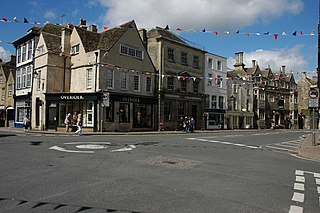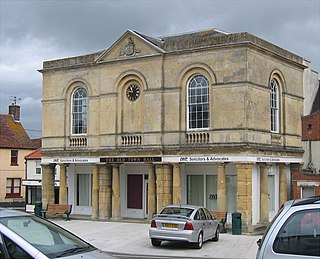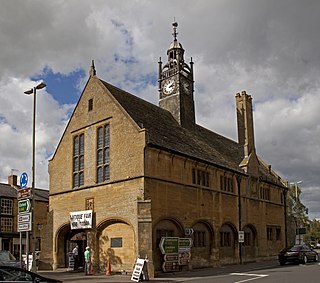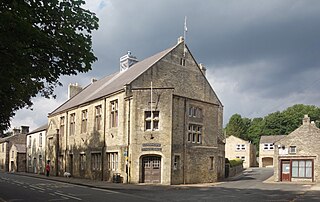
Tetbury is a town and civil parish inside the Cotswold district in Gloucestershire, England. It lies on the site of an ancient hill fort, on which an Anglo-Saxon monastery was founded, probably by Ine of Wessex, in 681. The population of the parish was 5,250 in the 2001 census, increasing to 5,472 at the 2011 census. The population further increased to 6,453 in the 2021 Census.

Lodge Park was built as a grandstand in the Sherborne Estate near the villages of Sherborne, Aldsworth and Northleach in Gloucestershire, England. The site is owned by the National Trust and the former grandstand is recorded in the National Heritage List for England as a designated Grade I listed building. It is England's only surviving 17th-century deer course and grandstand.

Chorley Town Hall is a municipal building in Market Street in Chorley, Lancashire, England.

Hitchin Town Hall is a municipal structure in Brand Street, Hitchin, Hertfordshire, England. The town hall, which was the headquarters of Hitchin Urban District Council, is a Grade II listed building.

The Old Town Hall is a municipal building in the Market Place in Westbury, Wiltshire, England. The structure, which was used as the local market hall and as a courtroom, is a Grade II* listed building.

Little Bolton Town Hall is a municipal building in All Saints Street, Little Bolton, Greater Manchester, England. The structure, which was the meeting place of the trustees of Little Bolton, is a Grade II listed building.

Dursley Town Hall, also known as Dursley Market Hall, is a municipal building in the Market Place, Dursley, Gloucestershire, England. The structure, which is mainly used for markets and community events, is a Grade II* listed building.

Chipping Campden Town Hall is a municipal building in the High Street, Chipping Campden, Gloucestershire, England. The building, which is the meeting place of Chipping Campden Town Council, is a Grade II* listed building.

Redesdale Hall, also referred to as Moreton-in-Marsh Town Hall, is a municipal building in the High Street, Moreton-in-Marsh, Gloucestershire, England. The building, which is used as an events venue, is a Grade II listed building.

Chipping Norton Town Hall is a municipal building in the Market Place, Chipping Norton, Oxfordshire, England. The building, which is used as an events venue, is a Grade II* listed building.

Helmsley Town Hall is a municipal building in the Market Place in Helmsley, North Yorkshire, England. The structure, which is used as a community library and a community events centre, is a grade II listed building.

Woodstock Town Hall is a municipal building in the Market Place in Woodstock, Oxfordshire, England. The building, which is used as a community events venue and the headquarters of Woodstock Town Council, is a Grade II listed building.

The Old Town Hall is a municipal building in the Market Place in Somerton, Somerset, England. The building, which is used as an arts centre, is a Grade II listed building.

Leconfield Hall, formerly Petworth Town Hall, is a municipal building in the Market Square in Petworth, West Sussex, England. The building, which is now used as a cinema, is a Grade II* listed building.

New Cumnock Town Hall is a municipal building in Castle, New Cumnock, East Ayrshire, Scotland. The structure, which is used as a community events venue, is a Category C listed building.

Gifford Town Hall is a municipal building in The Square, Gifford, East Lothian, Scotland. The structure, which is used as a community events venue, is a Category B listed building.

Wotton-under-Edge Town Hall is a municipal building in Market Street, Wotton-under-Edge, Gloucestershire, England. The structure, which operates as a community events venue, is a Grade II listed building.

Stanhope Town Hall is a former municipal building on Front Street, Stanhope, a town in County Durham, England. The building is not currently in use and is being marketed for sale.

The Old Town Hall is a former municipal building in Silver Street in Ottery St Mary, a town in Devon, in England. The structure is currently used as a local history museum.
Wiveliscombe Town Hall is a historic building on The Square in Wiveliscombe, a town in Somerset, in England. The building, which accommodates a series of retail businesses on the ground floor and an assembly room on the first floor, is a grade II listed building.




















